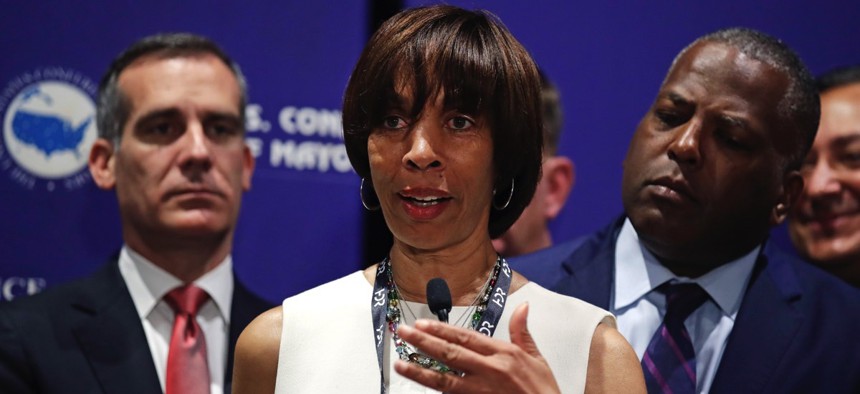How Baltimore and Tulsa Are Using Data to Foster Community

Baltimore Mayor Catherine Pugh Charles Krupa / AP Photo
“The great thing people need to understand about data—and this was the incorrect understanding I had at first—is it is not about efficiency,” said Tulsa’s mayor.
WASHINGTON — Baltimore’s “squeegee kids” have been known react angrily when drivers refuse a windshield wash for cash.
Motorists were complaining about the teenagers peddling their services in the city’s congested intersections.
So municipal government collected data on the problem, identifying about 100 teenagers squeegeeing around Baltimore and impeding traffic.
“Let’s be clear about who’s on the corner,” said Mayor Catherine Pugh on Friday at a data-based policymaking event in D.C. hosted by The Aspen Institute. “The difference is the anger levels that develop in some of these young people because you’re not going to give them money.”
City officials set about talking to 31 squeegee kids, probing into the details of their lives. They asked them questions about their situations, discovering that some were homeless, some dropouts, while struggled with problems like drug addiction and needed wraparound services.
Officials then took their research to affected business owners in the area and in October proposed a $2 million plan to divert squeegee kids from their corners and into jobs, schooling or rehab.
“The great thing people need to understand about data—and this was the incorrect understanding I had at first—is it is not about efficiency,” said Tulsa, Oklahoma Mayor G.T. Bynum. “It is a vehicle by which you can bring a community together.”
Bynum was elected in 2016 by a 17-point margin on a platform that included implementing metrics showing the city is bettering education and per capita income growth.
Under Bynum, Tulsa established a Civic Innovation Fellowship where citizens interested in using data to help city operations could participate. Six people were asked to look at the approximately 7,000 reported code violations a year, and found two-thirds of violators were non-occupant owners or landlords.
The city’s typical process was to alert violators by mail or flier, but people not living at the property wouldn’t see either. Now Tulsa is setting up text message notifications so landlords can proactively address issues and has already seen a 15 percent increase in compliance, Bynum said.
Because the city only has three data analysts on staff, it created a program called Urban Data Pioneers recruiting more from the community in a volunteer capacity—about 60 at the first meeting and 200 currently, Bynum said.
Tulsa has been “ripping off” successful ideas from other cities like Albuquerque, which has a program where panhandlers were paid to do cleanup work for the day with social services provided to them at lunchtime. The last six months, Tulsa has copied that approach with similar quantitative results to those in Albuquerque—a testament to data-driven policymaking’s benefits, Bynum said.
In January, Tulsa will release findings from its new partnership the Gallup-Tulsa CitiVoice Index, which examines how different communities relate to particular city issues. The granular data from the study will reveal things like trust in police is high among white residents but “almost the inverse of that” among African American ones, Bynum said.
“We have work to do in improving trust between our African American community and the Tulsa Police Department,” he said.
Dave Nyczepir is a News Editor at Government Executive’s Route Fifty and is based in Washington, D.C.
NEXT STORY: Connecting People Without Internet Access In Silicon Valley






